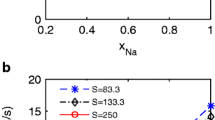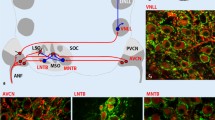Abstract
The mechano-electrical transduction in the squid axon was studied. A certain volume of solution was intracellularly injected, subsequently redrawn, by a microsyringe, and the resultant expansion and shrinkage of the cell was employed as the mechanical stimulus. Upon stimulation, two types of responses appeared: a depolarizing response and a hyperpolarizing response. The former appeared on large stimulation, but the shape and magnitude were variable even with the same stimulation, and the recovery was very slow. The latter appeared constantly on small stimulation. This hyperpolarizing response was associated with an increase in membrane conductance. Application of inward current through the membrane reversed the sign of the response. The reversal potential was 5–15 mV more negative than the resting potential. It was greatly affected by extracellular K+ concentration. Tetraethylammonium, applied intracellularly, reduced the amplitude of the hyperpolarizing response. However, 4-aminopyridine, tetrodotoxin, and procaine did not affect the response at all. The response became larger when the temperature was reduced. It is possible that the mechanically-induced hyperpolarizing response arises from an increase of potassium and leakage conductance.
Similar content being viewed by others
References
Armstrong CM (1969) Inactivation of the potassium conductance and related phenomena caused by quarternary ammonium ion injection in squid axons. J Gen Physiol 54:553–575
Baker PF, Hodgkin AL, Shaw TI (1962) Replacement of the axoplasm of giant nerve fibres with artificial solutions. J Physiol 164:330–354
Corey DP, Hudspeth AJ (1979) Ionic basis of the receptor potential in a vertebrate hair cell. Nature 281:675–677
de Peyer JE, Machemer H (1978) Hyperpolarizing and depolarizing mechanoreceptor potentials inStylonychia. J Comp Physiol 127:255–266
Ehrenstein G, Ganot G (1980) Mechanotransduction inMyxicola giant axons. Fed Proc 39:2063
Eyzaguirre C, Kuffler SW (1955) Processes of excitation in the dendrites and in the soma of single isolated sensory nerve cells of the lobster and crayfish. J Gen Physiol 39:87–119
Ganot G, Wong BS, Binstock L, Ehrenstein G (1981) Reversal potentials corresponding to mechanical stimulation and leakage current inMyxicola giant axons. Biochim Biophys Acta 649:487–491
Gray JAB, Ritchie JM (1954) Effects of stretch on single myelinated nerve fibres. J Physiol (Lond) 124:84–99
Gray JAB, Sato M (1953) Properties of the receptor potential in Pacinian corpuscles. J Physiol (Lond) 122:610–636
Hudspeth AJ, Corey DP (1977) Sensitivity, polarity, and conductance change in the response of vertebrate hair cells to controlled mechanical stimuli. Proc Natl Acad Sci USA 74:2407–2411
Ishiko N, Loewenstein WR (1961) Effects of temperature on the generator and action potentials of a sense organ. J Gen Physiol 45:105–124
Iwasa K, Tasaki I, Gibbons RC (1980) Swelling of nerve fibers associated with action potentials. Science 210:338–339
Julian FJ, Goldman DE (1962) The effects of mechanical stimulation on some electrical properties of axons. J Gen Physiol 46:297–313
Katz B (1950) Depolarization of sensory terminals and the initiation of impulses in the muscle spindle. J Physiol (Lond) 111:261–282b
Loewenstein WR, Ishiko N (1960) Effects of polarization of the receptor membrane and of the first Ranvier node in a sense organ. J Gen Physiol 43:981–998
Naitoh Y, Eckert R (1973) Sensory mechanisms inParamecium. II. Ionic basis of the hyperpolarizing mechanoreceptor potential. J Exp Biol 59:53–65
Russell IJ, Sellick PM (1977) Tuning properties of cochlear hair cells. Nature 267:858–860
Russell IJ, Sellick PM (1978) Intracellular studies of hair cells in the mammalian cochlea. J Physiol (Lond) 284:261–290
Tasaki I, Davis H, Eldredge DH (1954) Exploration of the cochlear potentials in the guinea pig with microelectrodes. J Acoust Soc Am 26:765–773
Terzuolo CA, Washizu Y (1962) Relation between stimulus strength, generator potential and impulse frequency in stretch receptor ofCrustacea. J Neurophysiol 25:56–66
Wells JB, Goldman DE (1981) Membrane potential changes during stretch in squid giant axons. Biophys J 33:91a
Author information
Authors and Affiliations
Rights and permissions
About this article
Cite this article
Terakawa, S., Watanabe, A. Electrical responses to mechanical stimulation of the membrane of squid giant axons. Pflugers Arch. 395, 59–64 (1982). https://doi.org/10.1007/BF00584969
Received:
Accepted:
Issue Date:
DOI: https://doi.org/10.1007/BF00584969




